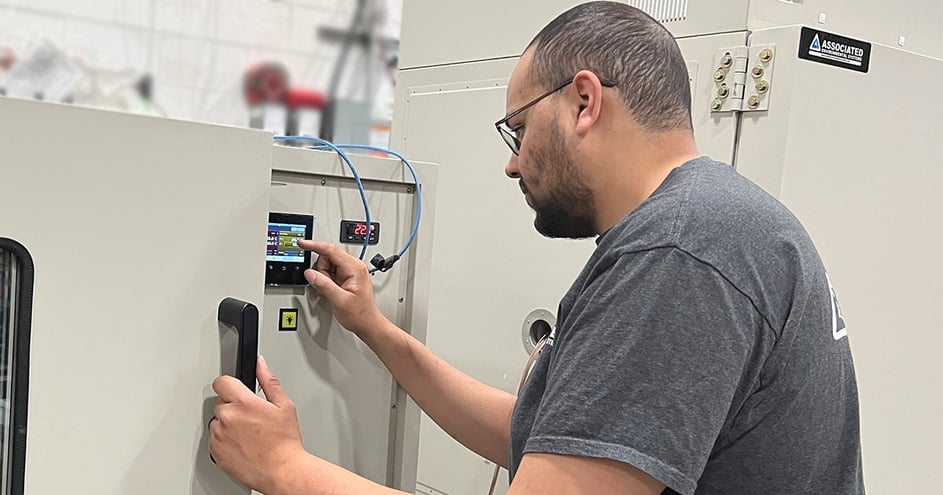What Happens With My Chambers If My Lab Loses Power?
You could be in the middle of running a test with your environmental chamber, and the power suddenly goes out. This could be caused by something as simple as a single downed powerline or more severe weather events such as snowstorms, flooding, or tornadoes.
Sudden power loss has the potential to not only disrupt testing but could damage your chambers.
Fortunately, there are a few preventative things you can do to avoid power loss and potential chamber damage when your lab loses power. Keep these in mind, particularly as inclement weather enters your area’s forecast.
When Your Test Chambers Lose Power
In the event of a power failure, your test chambers will shut down completely because they require a constant power source to function. If possible, you should disconnect the test chamber from the supply voltage as soon as possible to prevent any potential damage from surges when power is restored.
The loss of power to your chamber poses a few dangers:
Test chambers contain sensitive electrical parts. Although manufacturers take preventative measures to protect system components from power outages, some components, such as the XChange board, may be damaged by multiple power surges. It would be best to utilize surge protectors to prevent this scenario.
There could be potential for components to break down or degrade over time due to repeated power outages or surges. Again, utilizing surge protectors is a reliable way to protect your chamber and its electrical components.
You also need to keep in mind what type of testing you’re conducting.
For instance, there are increased dangers when conducting battery testing. A power interruption during battery testing amplifies the risk of a hazardous event, such as thermal runaway. The loss of power midway through a test also means battery safety features will no longer function.
Not only does this compromise the results of your test, but it makes battery components susceptible to damage, costing you money in the form of damaged products and delayed testing time.
As a result, it’s a good idea to avoid battery testing during inclement weather or invest in a generator to keep your lab powered in case of an outage (see the final section for more preventative measures).
Finally, remote testing technology won’t work with a power outage. This can create challenges if test chamber users are not present in your lab when a large number of active chambers lose power. For instance, you can no longer tell what’s happening in your chambers.
Furthermore, testing data will likely be lost, as well. This can be frustrating and set your testing schedule back.
After Your Test Chamber Loses Power
Once power is restored to your chambers, it’s best practice to verify all chamber features are working as intended. Contact your manufacturing for further assistance if something doesn't function as intended after a power outage. You should have them on standby not only for routine maintenance but for rare instances such as unexpected power loss.
If you’re conducting a test when the power goes out, you will generally want to restart the entire test once the power is restored. However, this depends on the following: the internal conditions of the test chamber pre-power outage, how long it has been without power, and the particular test you're running. Consult the test standards you’re using to inform your recovery decision. In most cases, the change in temperature or humidity conditions compromises your testing, and you’ll need to start all over again.
Fortunately, there are a few preventative measures you can take to ensure you minimize downtime and avoid damage to your test chambers.
Preventative Measures You Can Take
If you’re expecting inclement weather that might threaten your lab’s power, disconnect your chambers from their supply voltage. It’s suggested that you pause conducting any tests until you’re confident the threat to power has passed.
If you’re utilizing remote testing capabilities, labs should have a plan and systems in place to handle sudden power outages. This will vary between labs, but it is recommended to have an emergency power supply like a generator, and surge protectors for the lab. Otherwise, you could lose vital data and risk adding unnecessary wear to test chamber components.
To ensure your lab is well positioned for potential power outages, consult with a trusted manufacturer about optimal lab design. In addition to preparing you for potential power loss, a reliable manufacturer will advise you on a layout to promote efficiency and safety.
Ultimately, if you use surge protectors and maintain an emergency power supply, your lab should be in a great position to withstand threats to power, thus keeping your testing schedule on time and your devices under testing safe.
Associated Environmental Systems is an industry-leading test chamber designer and manufacturer. Contact us today to learn more about what you can do to prevent power loss to your environmental chambers and what to do when it happens.



